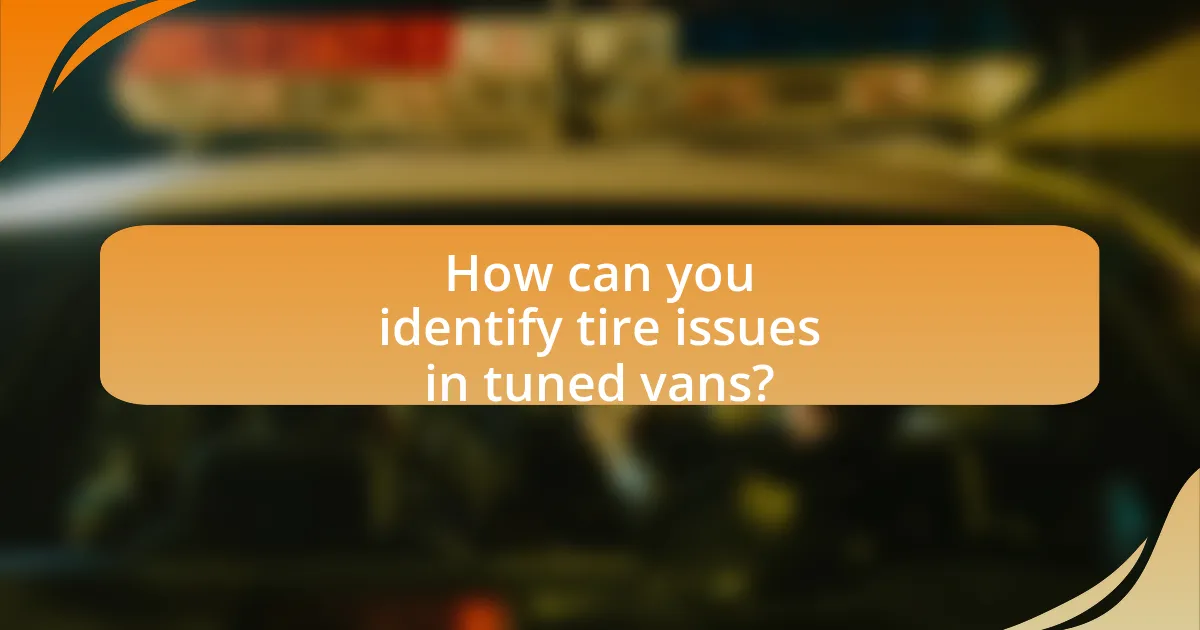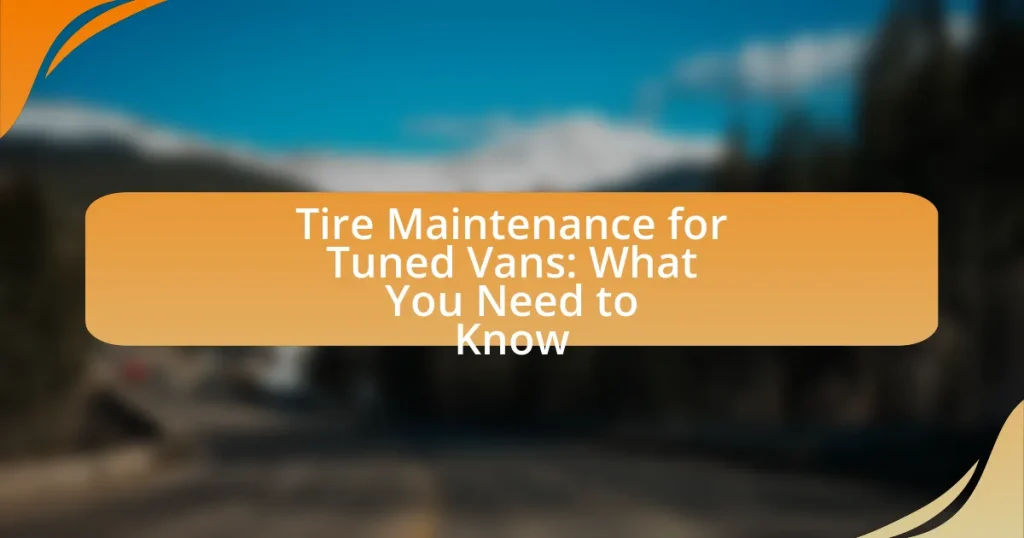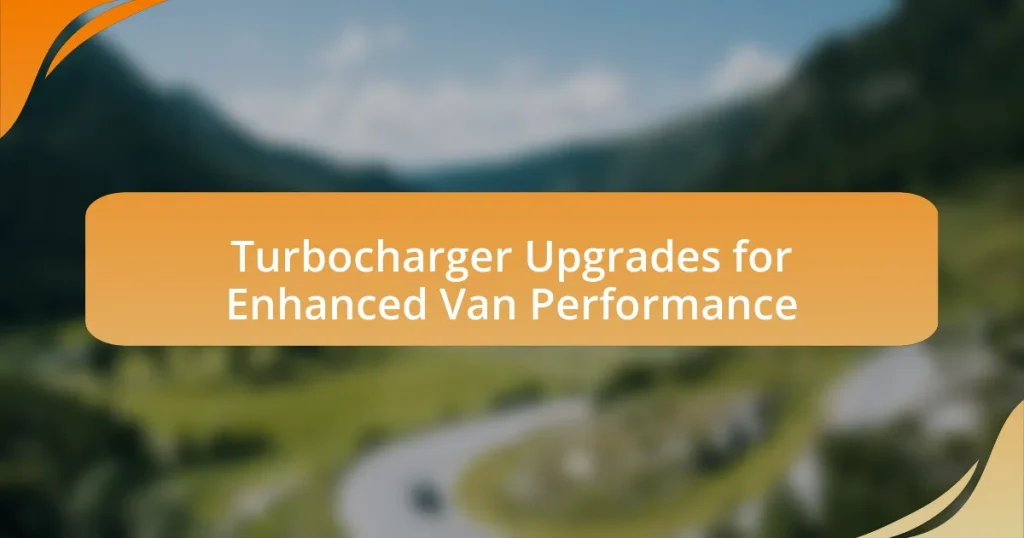Tire maintenance for tuned vans is essential for ensuring optimal performance, safety, and longevity. Key practices include regular inspections, maintaining proper tire pressure, rotating tires, and checking tread depth and alignment. Tuned vans face unique challenges due to enhanced performance demands, which can lead to uneven tire wear and increased risks of blowouts. This article outlines the importance of tire maintenance, the specific challenges faced by tuned vans, and best practices to extend tire lifespan and enhance vehicle safety and performance. Additionally, it discusses the role of technology and professional services in effective tire care.

What is Tire Maintenance for Tuned Vans?
Tire maintenance for tuned vans involves regular inspection, proper inflation, rotation, alignment, and tread depth checks to ensure optimal performance and safety. Regular inspections help identify wear patterns and potential issues, while maintaining proper tire pressure enhances fuel efficiency and handling. Rotating tires every 5,000 to 7,500 miles promotes even wear, and proper alignment prevents uneven tire wear and improves vehicle stability. Additionally, checking tread depth is crucial; tires should have at least 2/32 of an inch of tread for safe performance. These practices are essential for maximizing the lifespan of tires and ensuring the safety and performance of tuned vans.
Why is tire maintenance crucial for tuned vans?
Tire maintenance is crucial for tuned vans because it ensures optimal performance, safety, and longevity of the vehicle. Tuned vans often have enhanced power and handling characteristics, which place additional stress on tires. Regularly checking tire pressure, tread depth, and alignment helps prevent uneven wear and potential blowouts, which can lead to accidents. According to the National Highway Traffic Safety Administration, under-inflated tires can reduce fuel efficiency by up to 3% and increase the risk of tire failure. Therefore, maintaining tires in tuned vans is essential for maximizing performance and ensuring driver safety.
What unique challenges do tuned vans face regarding tire maintenance?
Tuned vans face unique challenges in tire maintenance primarily due to increased performance demands and altered weight distribution. The modifications often lead to higher speeds and cornering forces, which can accelerate tire wear and require more frequent inspections. Additionally, the suspension changes in tuned vans can affect tire alignment and pressure, necessitating regular adjustments to maintain optimal contact with the road. These factors contribute to a greater likelihood of uneven tire wear, which can compromise safety and performance if not addressed promptly.
How does tire maintenance impact the performance of tuned vans?
Tire maintenance significantly impacts the performance of tuned vans by ensuring optimal traction, handling, and stability. Properly maintained tires, including regular checks for pressure, tread depth, and alignment, enhance the vehicle’s grip on the road, which is crucial for tuned vans that often have modified power outputs. For instance, under-inflated tires can lead to increased rolling resistance and reduced fuel efficiency, while worn tread can compromise braking distances and cornering capabilities. Studies show that maintaining tire pressure within manufacturer specifications can improve fuel economy by up to 3.3%, directly affecting performance metrics. Therefore, consistent tire maintenance is essential for maximizing the performance benefits of tuning modifications in vans.
What are the key components of tire maintenance for tuned vans?
The key components of tire maintenance for tuned vans include regular tire pressure checks, tread depth monitoring, wheel alignment, and rotation. Maintaining proper tire pressure is crucial as it affects handling, fuel efficiency, and tire wear; for example, under-inflated tires can reduce fuel efficiency by up to 3%. Monitoring tread depth ensures adequate grip and safety, with a minimum depth of 2/32 inches recommended for safe driving. Regular wheel alignment prevents uneven tire wear and enhances vehicle stability, while rotating tires every 5,000 to 7,500 miles promotes even wear across all tires, extending their lifespan.
What types of tires are best suited for tuned vans?
High-performance tires are best suited for tuned vans. These tires are designed to provide enhanced grip, improved handling, and better stability at higher speeds, which are essential for vehicles that have been modified for performance. High-performance tires typically feature a softer rubber compound and a tread pattern optimized for traction, allowing tuned vans to maximize their capabilities on both the road and track.
How often should tire pressure be checked for tuned vans?
Tire pressure for tuned vans should be checked at least once a month. Regular monitoring is essential because tire pressure can fluctuate due to temperature changes and driving conditions, impacting vehicle performance and safety. According to the National Highway Traffic Safety Administration, maintaining proper tire pressure can improve fuel efficiency and extend tire life, making monthly checks a best practice for optimal maintenance.
What common tire maintenance practices should be followed?
Common tire maintenance practices include regular tire pressure checks, tread depth inspections, tire rotations, and alignment checks. Maintaining proper tire pressure is crucial, as under-inflated tires can reduce fuel efficiency by up to 3% for every 1 PSI drop in pressure. Tread depth should be monitored to ensure adequate grip; a minimum tread depth of 2/32 inches is recommended for safe driving. Tire rotations should occur every 5,000 to 7,500 miles to promote even wear, while alignment checks help prevent uneven tire wear and improve handling. Following these practices can enhance tire lifespan and vehicle safety.
How can regular tire rotation benefit tuned vans?
Regular tire rotation benefits tuned vans by promoting even tire wear, which enhances performance and extends tire lifespan. Tuned vans often experience uneven weight distribution and varying torque, leading to faster wear on specific tires. By rotating the tires regularly, typically every 5,000 to 7,500 miles, the wear is balanced across all tires, improving traction and handling. This practice can also prevent premature tire replacement, saving costs in the long run.
What is the importance of wheel alignment for tuned vans?
Wheel alignment is crucial for tuned vans as it ensures optimal handling, tire longevity, and overall vehicle performance. Proper alignment allows the tires to make full contact with the road, which enhances traction and stability, particularly important for tuned vans that may have modified suspensions. Misalignment can lead to uneven tire wear, reduced fuel efficiency, and compromised safety, as the vehicle may pull to one side or experience poor steering response. Studies indicate that maintaining correct wheel alignment can extend tire life by up to 25%, making it a vital aspect of tire maintenance for tuned vans.

How can you identify tire issues in tuned vans?
To identify tire issues in tuned vans, regularly inspect the tires for uneven wear patterns, bulges, or cracks. Uneven wear can indicate misalignment or improper inflation, while bulges or cracks suggest structural damage. Additionally, monitor tire pressure frequently, as tuned vans may require specific pressure settings due to modifications. According to the Tire Industry Association, maintaining proper tire pressure can enhance performance and safety, reducing the risk of blowouts and improving fuel efficiency. Regularly checking tread depth with a gauge ensures adequate traction, especially in performance-oriented vehicles.
What signs indicate that tires need maintenance?
Tires need maintenance when they show signs such as uneven wear, low tread depth, visible cracks, bulges, or vibrations while driving. Uneven wear can indicate misalignment or improper inflation, while low tread depth, measured with a tread depth gauge, should not fall below 2/32 of an inch for safe driving. Visible cracks or bulges suggest potential tire failure, and vibrations may indicate issues with balance or alignment. Regular inspections can help identify these signs early, ensuring safety and performance.
How can tread wear patterns inform you about tire health?
Tread wear patterns can indicate specific issues related to tire health, such as alignment problems, improper inflation, or suspension issues. For instance, uneven wear, like excessive wear on one edge, suggests misalignment, while center wear indicates over-inflation. According to the Tire Industry Association, monitoring tread wear can help identify these problems early, potentially extending tire life and improving vehicle safety. Regularly inspecting tread patterns allows for timely interventions, ensuring optimal performance and safety of tuned vans.
What are the symptoms of improper tire pressure in tuned vans?
Improper tire pressure in tuned vans manifests through several symptoms, including uneven tire wear, decreased fuel efficiency, and compromised handling. Uneven tire wear occurs because incorrect pressure leads to uneven contact with the road, causing specific areas of the tire to wear out faster. Decreased fuel efficiency results from increased rolling resistance when tires are under-inflated or over-inflated, which forces the engine to work harder. Compromised handling is evident when the van feels unstable or difficult to control, particularly during cornering or sudden maneuvers, as the tires do not maintain optimal contact with the road surface. These symptoms highlight the importance of regular tire pressure checks to ensure safety and performance in tuned vans.
What tools and equipment are necessary for tire maintenance?
The tools and equipment necessary for tire maintenance include a tire pressure gauge, a tire inflator, a lug wrench, a jack, and a tire tread depth gauge. A tire pressure gauge is essential for checking the air pressure in tires, which should be maintained according to the vehicle manufacturer’s specifications for optimal performance and safety. A tire inflator is used to add air to tires when needed, ensuring they are properly inflated. A lug wrench is necessary for removing and tightening lug nuts when changing tires, while a jack is required to lift the vehicle off the ground safely. Lastly, a tire tread depth gauge helps assess the tread wear on tires, which is crucial for determining when tires need to be replaced to maintain traction and safety on the road.
What basic tools should every tuned van owner have for tire care?
Every tuned van owner should have a tire pressure gauge, a tire inflator, a lug wrench, and a tire repair kit for effective tire care. A tire pressure gauge allows for accurate monitoring of tire pressure, which is crucial for safety and performance. A tire inflator enables quick inflation to the recommended pressure, ensuring optimal tire function. A lug wrench is essential for changing tires, as it provides the necessary leverage to remove and tighten lug nuts. Lastly, a tire repair kit, which typically includes plugs and tools for fixing punctures, is vital for addressing minor tire damage on the road. These tools collectively enhance tire maintenance and ensure the safety and performance of tuned vans.
How can technology assist in tire maintenance for tuned vans?
Technology can assist in tire maintenance for tuned vans through advanced monitoring systems and diagnostic tools. These systems utilize sensors to track tire pressure, temperature, and tread wear in real-time, allowing for proactive maintenance. For instance, tire pressure monitoring systems (TPMS) alert drivers to any deviations from optimal pressure, which is crucial for performance and safety in tuned vans. Additionally, software applications can analyze data from these sensors to predict when tires need rotation or replacement, enhancing longevity and performance. Studies show that regular monitoring can extend tire life by up to 25%, demonstrating the effectiveness of technology in maintaining tire health.

What are the best practices for tire maintenance in tuned vans?
The best practices for tire maintenance in tuned vans include regular tire pressure checks, consistent rotation, alignment adjustments, and tread depth monitoring. Maintaining the correct tire pressure is crucial, as under-inflated tires can lead to increased wear and reduced fuel efficiency, while over-inflated tires can compromise handling and safety. Tire rotation should occur every 5,000 to 7,500 miles to ensure even wear across all tires, which is particularly important for tuned vans that may experience uneven stress due to modifications. Regular alignment checks help prevent premature tire wear and improve handling, especially in vehicles with performance upgrades. Lastly, monitoring tread depth is essential; tires should be replaced when tread depth falls below 2/32 of an inch to maintain optimal traction and safety. These practices are supported by tire manufacturers and automotive experts, emphasizing their importance in prolonging tire life and ensuring vehicle safety.
How can you extend the lifespan of tires on tuned vans?
To extend the lifespan of tires on tuned vans, regularly maintain proper tire pressure and perform routine alignments. Maintaining the correct tire pressure prevents uneven wear and enhances fuel efficiency, while regular alignments ensure that tires wear evenly, reducing the risk of premature deterioration. According to the Tire Industry Association, under-inflated tires can wear out 25% faster than properly inflated ones, highlighting the importance of monitoring tire pressure. Additionally, rotating tires every 5,000 to 8,000 miles can further promote even wear, contributing to a longer lifespan.
What role does driving style play in tire wear for tuned vans?
Driving style significantly influences tire wear for tuned vans, as aggressive acceleration, hard braking, and sharp cornering can lead to uneven and accelerated tire degradation. Research indicates that driving habits can increase tire wear by up to 30% compared to more conservative driving styles, which promote even tire wear and longevity. For instance, a study by the Tire Industry Association found that maintaining a smooth driving approach can extend tire life by reducing excessive heat buildup and minimizing tread wear.
How can seasonal changes affect tire maintenance needs?
Seasonal changes significantly affect tire maintenance needs due to variations in temperature and road conditions. In winter, colder temperatures can lead to decreased tire pressure, requiring more frequent checks and adjustments to maintain optimal performance. Additionally, winter tires may be necessary for improved traction on snow and ice, while summer tires can wear out faster in high temperatures due to increased heat and road friction. Studies show that tire pressure can drop by about 1 PSI for every 10°F decrease in temperature, emphasizing the importance of regular monitoring during seasonal transitions.
What are the common mistakes to avoid in tire maintenance?
Common mistakes to avoid in tire maintenance include neglecting regular tire pressure checks, failing to rotate tires, and ignoring tread wear indicators. Regularly checking tire pressure is crucial, as under-inflated tires can lead to reduced fuel efficiency and increased tire wear. Tire rotation should occur every 5,000 to 7,500 miles to ensure even wear across all tires, which prolongs their lifespan. Additionally, ignoring tread wear indicators can compromise safety, as insufficient tread depth increases the risk of hydroplaning and reduces traction. According to the National Highway Traffic Safety Administration, maintaining proper tire care can enhance vehicle safety and performance.
How can neglecting tire maintenance impact safety and performance?
Neglecting tire maintenance significantly compromises both safety and performance. Poorly maintained tires can lead to reduced traction, increased stopping distances, and a higher risk of blowouts, all of which can result in accidents. For instance, according to the National Highway Traffic Safety Administration, tire-related issues contribute to approximately 11,000 crashes annually in the United States. Additionally, under-inflated tires can decrease fuel efficiency by up to 3%, negatively impacting overall vehicle performance. Regular tire checks, including pressure, tread depth, and alignment, are essential to ensure optimal safety and performance.
What misconceptions exist about tire maintenance for tuned vans?
One misconception about tire maintenance for tuned vans is that higher performance tires do not require regular pressure checks. In reality, tuned vans often experience increased tire wear and pressure fluctuations due to enhanced performance demands. Regularly checking tire pressure is crucial, as under-inflated tires can lead to reduced handling and increased tire degradation, which is supported by the National Highway Traffic Safety Administration, indicating that proper tire inflation can improve fuel efficiency and extend tire life.
What practical tips can enhance tire maintenance for tuned vans?
Regularly checking tire pressure is essential for enhancing tire maintenance for tuned vans. Maintaining the correct tire pressure ensures optimal contact with the road, improves fuel efficiency, and extends tire lifespan. According to the National Highway Traffic Safety Administration, under-inflated tires can reduce fuel efficiency by up to 3% for every 1 psi drop in pressure. Additionally, rotating tires every 5,000 to 7,500 miles helps promote even wear, which is crucial for tuned vans that may experience uneven stress due to modifications. Furthermore, inspecting tread depth regularly ensures adequate traction; a tread depth of 2/32 inches or more is recommended for safe driving. Lastly, aligning the wheels can prevent premature tire wear and improve handling, which is particularly important for tuned vans that may have altered suspension systems.
How can regular inspections prevent costly tire issues?
Regular inspections can prevent costly tire issues by identifying wear, damage, and improper inflation before they lead to failures. These inspections allow for early detection of problems such as uneven tread wear, which can indicate alignment issues, or low tire pressure, which can increase fuel consumption and lead to blowouts. According to the National Highway Traffic Safety Administration, maintaining proper tire pressure can improve fuel efficiency by up to 3.3%. Regular checks can also extend tire lifespan, as timely rotations and alignments can prevent premature wear, ultimately saving money on replacements and repairs.
What are the benefits of professional tire services for tuned vans?
Professional tire services for tuned vans enhance safety, performance, and longevity of tires. These services include precise alignment, balancing, and tire pressure checks, which are crucial for tuned vans that often experience modified handling characteristics. Proper alignment ensures that the tires wear evenly, reducing the risk of blowouts and improving fuel efficiency. Additionally, professional tire services utilize advanced equipment to detect issues that may not be visible to the untrained eye, such as uneven wear patterns or structural damage. This proactive approach helps maintain optimal traction and handling, essential for the performance of tuned vans.



